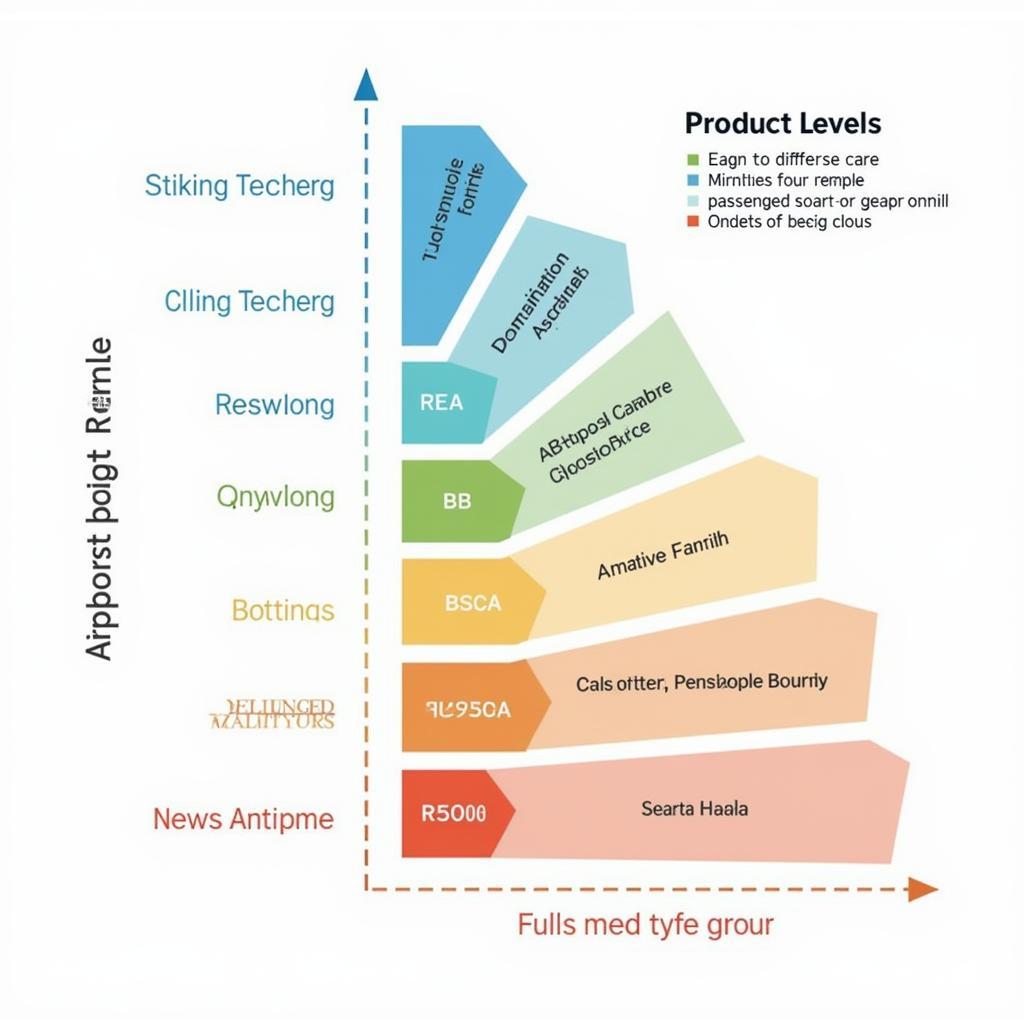Airports are complex ecosystems, and understanding the 5 product levels of airports is crucial for both airport operators and passengers. These levels categorize different aspects of the airport experience, ranging from the basic infrastructure to the premium services offered. This framework helps airports analyze their strengths and weaknesses, identify areas for improvement, and tailor their services to better meet passenger needs.
Decoding the 5 Product Levels: From Basic to Luxurious
The 5 product levels of airports provide a comprehensive framework for analyzing and optimizing the airport experience. These levels, ranging from basic to premium, allow airports to strategically cater to diverse passenger demographics and preferences. Let’s delve into each level:
Level 1: Basic Airport Infrastructure – The Foundation
This level encompasses the essential infrastructure that enables an airport to function. It includes runways, taxiways, terminals, and basic passenger facilities like restrooms and waiting areas. Without these fundamental elements, an airport simply cannot operate. This is the bedrock upon which all other levels are built.
Level 2: Operational Efficiency – Smooth Sailing Through the Airport
Level 2 focuses on the efficiency of airport operations. This includes aspects like check-in processes, security checkpoints, baggage handling, and gate management. A well-operated airport minimizes delays, ensures smooth passenger flow, and provides clear communication. Efficiency at this level is key to a positive passenger experience.
Level 3: Basic Passenger Amenities – Comfort and Convenience
Beyond the basic infrastructure and operational efficiency, Level 3 introduces amenities aimed at passenger comfort and convenience. This includes seating areas with charging stations, food and beverage outlets, retail shops, and Wi-Fi access. These amenities enhance the overall passenger journey and provide opportunities for relaxation and entertainment while waiting for flights.
Level 4: Enhanced Passenger Services – A Step Above
Level 4 elevates the airport experience with enhanced services designed to cater to specific passenger needs. This can include airport lounges, premium check-in facilities, personalized assistance services, and dedicated baggage handling. These services offer a higher level of comfort and convenience, often targeting business travelers and frequent flyers.
Level 5: Luxury and VIP Services – The Pinnacle of Airport Experience
The pinnacle of the airport product levels is Level 5, which focuses on luxury and VIP services. This includes exclusive lounges with spa treatments, gourmet dining options, private transportation within the airport, and personalized concierge services. These offerings cater to the most discerning travelers, providing an unparalleled level of comfort and exclusivity.
Why are Airport Product Levels Important?
Understanding the 5 product levels is crucial for airport management. It allows them to:
- Target different passenger segments: By offering services at various levels, airports can cater to a wider range of passengers, from budget travelers to high-end clients.
- Improve revenue generation: Premium services at higher levels offer opportunities for increased revenue generation through premium pricing.
- Enhance competitiveness: Offering a superior passenger experience through enhanced services helps airports stand out from the competition.
- Optimize resource allocation: Understanding the different levels allows airports to allocate resources effectively based on passenger demand and market needs.
 Airport Passenger Experience Levels: Comparing Amenities and Services at Each Level
Airport Passenger Experience Levels: Comparing Amenities and Services at Each Level
How Airports Can Leverage Product Levels for Success
Airports can use the 5 product levels as a strategic tool to enhance their overall performance and passenger satisfaction. By focusing on improvements at each level, they can create a more appealing and efficient travel experience. This can include:
- Investing in infrastructure upgrades: Modernizing facilities and expanding capacity can improve operational efficiency and passenger flow. This might be similar to the issues faced by some 24 hour airports uk.
- Streamlining processes: Implementing technology and optimizing procedures can enhance efficiency at check-in, security, and baggage handling.
- Enhancing amenities: Offering comfortable seating, diverse food and beverage options, and reliable Wi-Fi can improve the overall passenger experience.
 Airport Revenue Generation Strategies: Maximizing Revenue through Different Product Levels(https://airport-bbi.com/dreamfolks-airport-lounge/) revenue model.]
Airport Revenue Generation Strategies: Maximizing Revenue through Different Product Levels(https://airport-bbi.com/dreamfolks-airport-lounge/) revenue model.]
Conclusion
The 5 product levels of airports provide a valuable framework for understanding and optimizing the airport experience. By strategically developing offerings at each level, airports can meet the diverse needs of passengers, enhance their competitive edge, and drive revenue growth. Understanding these levels is key to navigating the complex landscape of modern air travel and creating a truly seamless and enjoyable journey for all. Thinking of the next airport you travel through, consider which of these levels are most important to you. For more detailed information on airport facilities and services, you might find the article about 5 star airport helpful.
FAQ
- What is the most basic product level of an airport? Level 1: Basic Airport Infrastructure
- What level focuses on operational efficiency? Level 2
- What level introduces passenger amenities like food and beverage outlets? Level 3
- What level includes premium services like airport lounges? Level 4
- What is the highest product level of an airport? Level 5: Luxury and VIP services
- Why are airport product levels important? They help airports cater to different passenger needs and optimize resources.
- How can airports use product levels to improve revenue? By offering premium services at higher levels.
Need more assistance? Contact us 24/7: Phone: +13089626264, Email: [email protected], Address: 404 Bothwell St, Oxford, NE 68967, USA.
